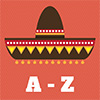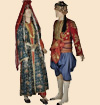Turkey
 In the past, Turkish Muslim ladies often covered their faces with an almost sheer veil called “yashmak”. Although, such an accessory is today considered a symbol of gender oppression by many. But Turkish women wore this niqab-style item daily. While this tradition is practically gone in Turkey by now, married women in Turkmenistan still use a yashmak these days. What’s your opinion on obligatory face veils for ladies?
In the past, Turkish Muslim ladies often covered their faces with an almost sheer veil called “yashmak”. Although, such an accessory is today considered a symbol of gender oppression by many. But Turkish women wore this niqab-style item daily. While this tradition is practically gone in Turkey by now, married women in Turkmenistan still use a yashmak these days. What’s your opinion on obligatory face veils for ladies?
- Details
- Category: Turkey
- Hits: 6790
 The traditional Ottoman male clothing in the 17th century looked pretty and unique – ornate, often made from silk, beautifully patterned, and designed in an original fashion. Some of the garments were commonly used not only in the Ottoman Empire but by its neighbors as well, but the whole outfit allowed you to recognize the wearer at once. Especially, the typical turban. The silhouette and cut of the attire also emanated a distinctive Ottoman charm and noble air.
The traditional Ottoman male clothing in the 17th century looked pretty and unique – ornate, often made from silk, beautifully patterned, and designed in an original fashion. Some of the garments were commonly used not only in the Ottoman Empire but by its neighbors as well, but the whole outfit allowed you to recognize the wearer at once. Especially, the typical turban. The silhouette and cut of the attire also emanated a distinctive Ottoman charm and noble air.
- Details
- Category: Turkey
- Hits: 15028
 A short time ago, we’ve published the first portion of old photos of Turkish traditional outfits from a rather large collection. Here is the second portion of photos. Even more authentic men’s, women’s, and kids’ Turkish costumes from the second half of the 19th century. Even more of extraordinary accessories, weapons, jewels, etc. It’s a pity, these photos are black&white so you can’t distinguish the color palette of the garments and most of embellishments. Nevertheless, we can see the cut and design, forms and shapes of these clothing articles.
A short time ago, we’ve published the first portion of old photos of Turkish traditional outfits from a rather large collection. Here is the second portion of photos. Even more authentic men’s, women’s, and kids’ Turkish costumes from the second half of the 19th century. Even more of extraordinary accessories, weapons, jewels, etc. It’s a pity, these photos are black&white so you can’t distinguish the color palette of the garments and most of embellishments. Nevertheless, we can see the cut and design, forms and shapes of these clothing articles.
- Details
- Category: Turkey
- Hits: 5342
 We’ve found a large collection of vintage photos of Turkish folk costumes from the end of the 19th century. And we’d like to share them with you. Unfortunately, these are black&white photos so you can’t distinguish the color palette of the garments and most of the ornamentation. But still, we can see the cut, design, and shapes of Turkish multilayered male, female, and kid costumes, their awesome accessories (often, pretty bizarre, too). So, here is the first portion of photos.
We’ve found a large collection of vintage photos of Turkish folk costumes from the end of the 19th century. And we’d like to share them with you. Unfortunately, these are black&white photos so you can’t distinguish the color palette of the garments and most of the ornamentation. But still, we can see the cut, design, and shapes of Turkish multilayered male, female, and kid costumes, their awesome accessories (often, pretty bizarre, too). So, here is the first portion of photos.
- Details
- Category: Turkey
- Hits: 5283
 The Ottoman Empire (the 14th – early 20th century) was a very large, very powerful, and very wealthy state. The clothing of its rulers and their concubines was the most fashionable and high-quality – the most expensive fabrics only, gold embroidery, plenty of gold and silver jewelry, etc. But the cut and design of these garments, of course, were rather modest and restrained because it was a Muslim country. Here you can see several beautiful vintage clothing articles from museum collections that represent the Ottoman Empire.
The Ottoman Empire (the 14th – early 20th century) was a very large, very powerful, and very wealthy state. The clothing of its rulers and their concubines was the most fashionable and high-quality – the most expensive fabrics only, gold embroidery, plenty of gold and silver jewelry, etc. But the cut and design of these garments, of course, were rather modest and restrained because it was a Muslim country. Here you can see several beautiful vintage clothing articles from museum collections that represent the Ottoman Empire.
- Details
- Category: Turkey
- Hits: 4478
 The Kurdish traditional clothing is still used sometimes today, though, mostly by older people. Particularly, the ancient outfit called the “shal and shepik” can be rarely seen these days in everyday life; it is mostly worn as a ceremonial dress. These clothing pieces were even banned by Turkish politicians at one time – they were called “uniforms for illegal organizations”. But in reality, shal and shepik are just the handmade folk garments that are considered Kurdish cultural heritage.
The Kurdish traditional clothing is still used sometimes today, though, mostly by older people. Particularly, the ancient outfit called the “shal and shepik” can be rarely seen these days in everyday life; it is mostly worn as a ceremonial dress. These clothing pieces were even banned by Turkish politicians at one time – they were called “uniforms for illegal organizations”. But in reality, shal and shepik are just the handmade folk garments that are considered Kurdish cultural heritage.
- Details
- Category: Turkey
- Hits: 11522
 One of the most extraordinary museums of traditional clothing, accessories, and jewelry in Turkey is based on a private collection. The woman named Sadberk Koç dedicated her life to collecting precious Turkish antiques from the 18th-19th centuries. She managed to gather a great number of items. And after her death, her husband created the Sadberk Hanim Museum or Lady Sadberk Museum to show her collection to the Turkish people and the whole world. This collection is marvelous! Just one person owned enough valuables for the whole museum!
One of the most extraordinary museums of traditional clothing, accessories, and jewelry in Turkey is based on a private collection. The woman named Sadberk Koç dedicated her life to collecting precious Turkish antiques from the 18th-19th centuries. She managed to gather a great number of items. And after her death, her husband created the Sadberk Hanim Museum or Lady Sadberk Museum to show her collection to the Turkish people and the whole world. This collection is marvelous! Just one person owned enough valuables for the whole museum!
- Details
- Category: Turkey
- Hits: 9303
 Traditional pieces of the male and female national costumes in Turkey: aigrette, anteri, bademler, başmak, bindalli, binish, çarik, çedik, cepken, çizme, cübbe, don, entari, ferace, fez, gomlek, hirka, iki etek entari, jubba, kaftan, kalpak, kemer, keşan, kushak, kütahya, mest, mintan, peştemal, potur, qamis, salta, sarik, shalvar, tek etek entari, turban, üç etek entari, yasmak, yelek, and zibin.
Traditional pieces of the male and female national costumes in Turkey: aigrette, anteri, bademler, başmak, bindalli, binish, çarik, çedik, cepken, çizme, cübbe, don, entari, ferace, fez, gomlek, hirka, iki etek entari, jubba, kaftan, kalpak, kemer, keşan, kushak, kütahya, mest, mintan, peştemal, potur, qamis, salta, sarik, shalvar, tek etek entari, turban, üç etek entari, yasmak, yelek, and zibin.
- Details
- Category: Turkey
- Hits: 2970
 Turkey is a country with old clothing traditions. Their roots are in the Ottoman Empire which has formed Turkish cultural and traditional heritage pretty much. Even hundreds of years after the Ottoman Empire, Turkish national costume has a lot of features typical for those days. But today few people in Turkey wear traditional clothing in day-to-day life. Men usually use European style of clothes or mix some elements of the folk dress with western pieces of attire. Women wear national costumes more often, they retained the national dress more fully and keep the traditions more carefully.
Turkey is a country with old clothing traditions. Their roots are in the Ottoman Empire which has formed Turkish cultural and traditional heritage pretty much. Even hundreds of years after the Ottoman Empire, Turkish national costume has a lot of features typical for those days. But today few people in Turkey wear traditional clothing in day-to-day life. Men usually use European style of clothes or mix some elements of the folk dress with western pieces of attire. Women wear national costumes more often, they retained the national dress more fully and keep the traditions more carefully.
- Details
- Category: Turkey
- Hits: 230426

